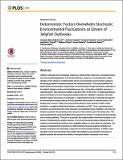Por favor, use este identificador para citar o enlazar a este item:
http://hdl.handle.net/10261/128587COMPARTIR / EXPORTAR:
 SHARE SHARE
 CORE
BASE CORE
BASE
|
|
| Visualizar otros formatos: MARC | Dublin Core | RDF | ORE | MODS | METS | DIDL | DATACITE | |

| Título: | Deterministic Factors Overwhelm Stochastic Environmental Fluctuations as Drivers of Jellyfish Outbreaks |
Autor: | Benedetti-Cecchi, Lisandro; Canepa, Antonio CSIC ORCID CVN; Fuentes, Veronica CSIC ORCID; Tamburello, Laura; Purcell, Jennifer E.; Piraino, Stefano; Roberts, Jason; Boero, Ferdinando; Halpin, Pat | Fecha de publicación: | 20-oct-2015 | Editor: | Public Library of Science | Citación: | PLoS ONE 10(10): e0141060 (2015) | Resumen: | Jellyfish outbreaks are increasingly viewed as a deterministic response to escalating levels of environmental degradation and climate extremes. However, a comprehensive understanding of the influence of deterministic drivers and stochastic environmental variations favouring population renewal processes has remained elusive. This study quantifies the deterministic and stochastic components of environmental change that lead to outbreaks of the jellyfish Pelagia noctiluca in the Mediterranen Sea. Using data of jellyfish abundance collected at 241 sites along the Catalan coast from 2007 to 2010 we: (1) tested hypotheses about the influence of time-varying and spatial predictors of jellyfish outbreaks; (2) evaluated the relative importance of stochastic vs. deterministic forcing of outbreaks through the environmental bootstrap method; and (3) quantified return times of extreme events. Outbreaks were common in May and June and less likely in other summer months, which resulted in a negative relationship between outbreaks and SST. Cross- and along-shore advection by geostrophic flow were important concentrating forces of jellyfish, but most outbreaks occurred in the proximity of two canyons in the northern part of the study area. This result supported the recent hypothesis that canyons can funnel P. noctiluca blooms towards shore during upwelling. This can be a general, yet unappreciated mechanism leading to outbreaks of holoplanktonic jellyfish species. The environmental bootstrap indicated that stochastic environmental fluctuations have negligible effects on return times of outbreaks. Our analysis emphasized the importance of deterministic processes leading to jellyfish outbreaks compared to the stochastic component of environmental variation. A better understanding of how environmental drivers affect demographic and population processes in jellyfish species will increase the ability to anticipate jellyfish outbreaks in the future | Descripción: | 16 pages, 4 figures, 1 table, supporting Information http://dx.doi.org/10.1371/journal.pone.0141060 | Versión del editor: | http://dx.doi.org/10.1371/journal.pone.0141060 | URI: | http://hdl.handle.net/10261/128587 | DOI: | 10.1371/journal.pone.0141060 | Identificadores: | doi: 10.1371/journal.pone.0141060 issn: 1932-6203 e-issn: 1932-6203 |
| Aparece en las colecciones: | (ICM) Artículos |
Ficheros en este ítem:
| Fichero | Descripción | Tamaño | Formato | |
|---|---|---|---|---|
| Benedetti_et_al_2015.pdf | 520,55 kB | Adobe PDF |  Visualizar/Abrir |
CORE Recommender
PubMed Central
Citations
5
checked on 02-abr-2024
SCOPUSTM
Citations
31
checked on 17-abr-2024
WEB OF SCIENCETM
Citations
27
checked on 24-feb-2024
Page view(s)
266
checked on 19-abr-2024
Download(s)
199
checked on 19-abr-2024
Google ScholarTM
Check
Altmetric
Altmetric
Artículos relacionados:
NOTA: Los ítems de Digital.CSIC están protegidos por copyright, con todos los derechos reservados, a menos que se indique lo contrario.
